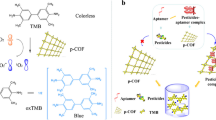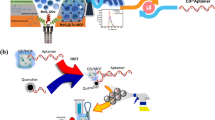Abstract
Herein, histidine, as a protective agent, was applied for the synthesis of copper nanoclusters (histidine-Cu NCs) by using ascorbic acid as an efficient reducing agent. The as-fabricated fluorescent histidine-Cu NCs displayed blue-green emission wavelength at 492 nm with the excitation of 410 nm. Using histidine-Cu NCs as a novel nanoprobe, the fluorescent “turn-off” mechanism was developed for the determination of furaltadone accompanying linear attenuation of fluorescence at 492 nm. Furaltadone acted as a quencher and ln (F0/F) value of histidine-Cu NCs had an excellent linear relationship of furaltadone concentrations (0.5–500 μM) (the F0 and F are referred to the fluorescence intensity of probe without and with furaltadone), along with the detection limit and linear fit constant of 0.085 μM and 0.9948, respectively. The fluorescence quenching of histidine-Cu NCs demonstrated good selectivity for furaltadone over other potential control substances. The quenching mechanism might be assumed to be static quenching. This system was proved to be an appropriate detection pattern for furaltadone sensing in real medical samples.





Similar content being viewed by others
References
Amalraj AJJ, Murthy UN, Sea-Fue W (2021) Ultrasensitive electrochemical detection of an antibiotic drug furaltadone in fish tissue with a ZnO–ZnCo2O4 self-assembled nano-heterostructure as an electrode material. Microchem J 169:106566. https://doi.org/10.1016/j.microc.2021.106566
Anusuyadevi K, Wu SP, Velmathi S (2021) Reversible enhancement of fluorescence in acidic pH driven by tryptophan stabilized copper nanoclusters and its application in bioimaging. J Photoch Photobio A 421:113526. https://doi.org/10.1016/j.jphotochem.2021.113526
Aparna A, Sreehari H, Chandran A, Anjali KP, Mary Alex A, Anuvinda P, Gouthami GB, Pillai NP, Parvathy N, Sadanandan S, Saritha A (2022) Ligand-protected nanoclusters and their role in agriculture, sensing and allied applications. Talanta 239:123134. https://doi.org/10.1016/j.talanta.2021.123134
Bahota AS, Singh KK, Kumar R, Tandon P (2022) Ab-initio simulation of the interaction of gold nanoclusters with glycine. J Mol Struct 1266:133447. https://doi.org/10.1016/j.molstruc.2022.133447
Banerjee C, Kuchlyan J, Banik D, Kundu N, Roy A, Ghosh S, Sarkar N (2014) Interaction of gold nanoclusters with IR light emitting cyanine dyes: a systematic fluorescence quenching study. Phys Chem Chem Phys 16:17272–17283. https://doi.org/10.1039/C4CP02563F
Barbosa J, Moura S, Barbosa R, Ramos F, da Silveira MIN (2007) Determination of nitrofurans in animal feeds by liquid chromatography-UV photodiode array detection and liquid chromatography-ionspray tandem mass spectrometry. Anal Chim Acta 586:359–365. https://doi.org/10.1016/j.aca.2006.11.053
Bener M, Burak Şen F, Apak R (2022) Protamine gold nanoclusters-based fluorescence turn-on sensor for rapid determination of Trinitrotoluene (TNT). Spectroch Acta A 279:121462. https://doi.org/10.1016/j.saa.2022.121462
Cai ZF, Zhang CF, Jia K (2020a) L-Tyrosine protected Cu nanoclusters for reversible pH-sensors. Chemi Pap 74:1831–1838. https://doi.org/10.1007/s11696-019-01027-x
Cai ZF, Zhu RT, Zhang CF, Hao EX, Zhao J, Wu TQ (2020b) One-pot green synthesis of L-proline-stabilized copper nanoclusters for quercetin sensing. Chem Pap 74:3839–3846. https://doi.org/10.1007/s11696-020-01199-x
Cai ZF, Pang SL, Wu LL, Hao EX, Rong JX (2021) Highly sensitive and selective fluorescence sensing of nitrofurantoin based on water-soluble copper nanoclusters. Spectrochim Acta A 255:119737. https://doi.org/10.1016/j.saa.2021.119737
Cai ZF, Li HY, Wang XS, Min C, Wen JQ, Fu RX, Dai ZY, Chen J, Guo MZ, Yang HJ, Bai PP, Lu XM, Wu Ta WuY (2022a) Highly luminescent copper nanoclusters as temperature sensors and “turn off” detection of oxytetracycline. Colloid Surf A 647:129202. https://doi.org/10.1016/j.colsurfa.2022.129202
Cai ZF, Wang XS, Li HY, Cao PL, Han XR, Guo PY, Cao FY, Liu JX, Sun XX, Li T, Wu Y, Zhang S (2022b) One-step synthesis of blue emission copper nanoclusters for the detection of furaltadone and temperature. Spectroch Acta A 279:121408. https://doi.org/10.1016/j.saa.2022.121408
Chauhan C, Bhardwaj V, Sahoo SK (2021) Sequential detection of vitamin B6 cofactors and nitroaromatics by using albumin-stabilized fluorescent copper nanoclusters. Microchem J 170:06778. https://doi.org/10.1016/j.microc.2021.106778
Chen YJ, Chang WH, Li CY, Chiu YC, Huang CC, Lin CH (2021) Direct synthesis of monolayer gold nanoparticles on epoxy based photoresist by photoreduction and application to surface-enhanced Raman sensing. Mater Des 197:109211. https://doi.org/10.1016/j.matdes.2020.109211
Chu PS, Lopez MI (2005) Liquid Chromatography-tandem mass spectrometry for the determination of protein-bound residues in shrimp dosed with nitrofurans. J Agric Food Chem 53:8934–8939. https://doi.org/10.1021/jf051615o
De Conto JF, Oliveira MR, Oliveira MM, Brandao TG, Campos KV, Santanna CC, Egues SM (2018) One-pot synthesis and modification of silica nanoparticles with 3-chloropropyl-trimethoxysilane assisted by microwave irradiation. Chem Eng Commun 205:533–537. https://doi.org/10.1080/10426500600917094
Du YT, Yi D, Wang X (2022) Carbon-rehybridization-induced templated growth of metal nanoclusters on graphene moiré patterns. Carbon 192:295–300. https://doi.org/10.1016/j.carbon.2022.03.002
Farrag M (2022) Electrostatic adsorption of ultra-small silver nanoclusters on titanium dioxide modified mesoporous MCM-41as a high-performance photocatalyst for wastewater treatment. J Photoch Photobio A 422:113551. https://doi.org/10.1016/j.jphotochem.2021.113551
Galeano Diaz T, Guiberteau Cabanillas A, Acedo Valenzuela MI, Correa CA, Salinas F (1997) Determination of nitrofurantoin, furazolidone and furaltadone in milk by high-performance liquid chromatography with electrochemical detection. J Chromatogr A 764:243–248. https://doi.org/10.1016/S0021-9673(96)00899-0
Hoenicke K, Gatermann R, Hartig L, Mandix M, Otte S (2004) Formation of semicarbazide (SEM) in food by hypochlorite treatment: is SEM a specific marker for nitrofurazone abuse? Food Addit Contam 21:526–537. https://doi.org/10.1080/02652030410001712484
Jester ELE, Abraham A, Wang YS, El Said KR, Plakas SM (2014) Performance evaluation of commercial ELISA kits for screening of furazolidone and furaltadone residues in fish. Food Chem 145:593–598. https://doi.org/10.1016/j.foodchem.2013.08.090
Jorabchi MN, Abbaspour M, Goharshadi EK, Wohlrab S (2022) Ag, Au, Pt, and Au-Pt nanoclusters in [N1114][C1SO3] ionic liquid: a molecular dynamics study. J Mol Liq 360:119447. https://doi.org/10.1016/j.molliq.2022.119447
Leston S, Nunes M, Freitas A, Barbosa J, Ramos F, Pardal MÂ (2011) A LC-MS/MS methodology to determine furaltadone residues in the macroalgae Ulva lactuca. J Chromatogr B 879:3832–3836. https://doi.org/10.1016/j.jchromb.2011.10.030
Lin SM, Geng S, Li N, Liu SG, Li NB, Luo HQ (2017) L-Histidine-protected copper nanoparticles as a fluorescent probe for sensing ferric ions. Sensor Actuat B 252:912–918. https://doi.org/10.1016/j.snb.2017.06.079
López-Hernández I, Truttmann V, Barrabés N, Rupprechter G, Rey F, Mengual J, Palomares AE (2022) Gold nanoclusters supported on different materials as catalysts for the selective alkyne semihydrogenation. Catal Today 394–396:34–40. https://doi.org/10.1016/j.cattod.2022.02.014
Murgunde BK, Mulla R, Rabinal MK (2020) A rapid synthesis of silver nanoparticle foam by ultrasonication. J Porous Mat 27:1727–1733. https://doi.org/10.1007/s10934-020-00951-8
Packirisamy V, Subramanian R, Pandurangan P (2022) Solvent-driven thiol protected luminescent cobalt nanoclusters. J Mol Liq 354:118857. https://doi.org/10.1016/j.molliq.2022.118857
Patel S, Patel P, Chodvadiya D, Som NN, Jha PK (2022) Adsorption performance of C12, B6N6 and Al6N6 nanoclusters towards hazardous gas molecules: a DFT investigation for gas sensing and removal application. J Mol Liq 352:118702. https://doi.org/10.1016/j.molliq.2022.118702
Pimpitak U, Putong S, Komolpis K, Petsom A, Palaga T (2009) Development of a monoclonal antibody-based enzyme-linked immunosorbent assay for detection of the furaltadone metabolite, AMOZ, in fortified shrimp samples. Food Chem 116:785–791. https://doi.org/10.1016/j.foodchem.2009.03.028
Qin LF, Zhang KW, Feng B, Zhang P, Qing TP, Fei JJ (2022) Proximity sequence-dependent spectral conversion of silver nanoclusters and construction of ratiometric nanoprobe. Chem Eng J 441:136001. https://doi.org/10.1016/j.cej.2022.136001
Santhosh K, Patra S, Soumya S, Khara DC, Samanta A (2011) Fluorescence quenching of CdS quantum dots by 4-azetidinyl-7-nitrobenz-2-oxa-1,3-diazole: a mechanistic study. ChemPhysChem 12:2735–2741. https://doi.org/10.1002/cphc.201100515
Shu JH, He LM, Ding HZ, Wang LQ, Guo HY, Gao Y, Dzakahb EE, Zeng ZL (2014) Synthesis of furaltadone metabolite, 3-amino-5-morpholinomethyl-2-oxazolidone (AMOZ) and novel haptens for the development of a sensitive enzymelinked immunosorbent assay (ELISA). Anal Methods 6:2306–2313. https://doi.org/10.1039/C3AY41145A
Sivan SE, Kang KH, Han SJ, Okello OFN, Choi SY, Sudheeshkumar V, Scott RWJ, Chae HJ, Park S, Lee UH (2022) Facile MOF-derived one-pot synthetic approach toward Ru single atoms, nanoclusters, and nanoparticles dispersed on CeO2 supports for enhanced ammonia synthesis. J Catal 408:316–328. https://doi.org/10.1016/j.jcat.2022.03.019
Song YF, Zhang TY, Zhou GD, Liu PZ, Yan XL, Xu BS, Guo JJ (2022) Cu nanoclusters on N-doped carbon nanotubes as efficient electrocatalyst for oxygen reduction reaction. Appl Surf Sci 589:53022. https://doi.org/10.1016/j.apsusc.2022.153022
Vass M, Kruska K, Franek M (2008) Nitrofuran antibiotics: a review on the application, prohibition and residual analysis. Vet Med 53:469–500. https://doi.org/10.17221/1979-VETMED
Wang XS, Zhang S (2022) Trypsin stabilized copper nanoclusters as a highly sensitive and selective probe for fluorescence sensing of morin and temperature. Colloid Surf A 649:129458. https://doi.org/10.1016/j.colsurfa.2022.129458
Wang X, Li XB, Chen WF, Wang RL, Bian W, Choi MMF (2018) Phosphorus doped graphitic carbon nitride nanosheets as fluorescence probe for the detection of baicalein. Spectrochim Acta A 198:1–6. https://doi.org/10.1016/j.saa.2018.02.062
Wang DW, Jiang SH, Liang YY, Wang XB, Zhuang XM, Tian CY, Luan F, Chen LX (2022) Selective detection of enrofloxacin in biological and environmental samples using a molecularly imprinted electrochemiluminescence sensor based on functionalized copper nanoclusters. Talanta 236:122835. https://doi.org/10.1016/j.talanta.2021.122835
Xu ZL, Shen YD, Sun YM, Campbell K, Tian YX, Zhang SW, Lei HT, Jiang YM (2013) Novel hapten synthesis for antibody production and development of an enzyme-linked immunosorbent assay for determination of furaltadone metabolite 3-amino-5-morpholinomethyl-2-oxazolidinone (AMOZ). Talanta 103:306–313. https://doi.org/10.1016/j.talanta.2012.10.059
Yan C, Teng J, Liu FY, Yao BB, Xu ZL, Yao L, Chen W (2020) Signal amplified enzyme-linked immunosorbent assay with gold nanoparticles for sensitive detection of trace furaltadone metabolite. Microchem J 159:105414. https://doi.org/10.1016/j.microc.2020.105414
Yao S, Pang B, Fu YL, Song XL, Xu K, Li J, Wang J, Zhao C (2022) Multiplex detection of foodborne pathogens using inductively coupled plasma mass spectrometry, magnetic separation and metal nanoclusters-mediated signal amplification. Sensor Actuat B 359:131581. https://doi.org/10.1016/j.snb.2022.131581
Zhang S, Li JH, Huang SY, Ma XR, Zhang CF (2021) Novel blue-emitting probes of polyethyleneimine-capped copper nanoclusters for fluorescence detection of quercetin. Chem Pap 75:3761–3769. https://doi.org/10.1007/s11696-021-01624-9
Zheng X, Chen QM, Zhang ZX, Wang ZL, Gong ZJ (2022) An aggregation-induced emission copper nanoclusters fluorescence probe for the sensitive detection of tetracycline. Microchem J 180:107570. https://doi.org/10.1016/j.microc.2022.107570
Acknowledgements
We would like to thank the Scientific and Technological Innovation Programs of Higher Education Institutions in Shanxi (No.2021L433) and College Students’ Innovation Program of Taiyuan Normal University (No. CXCY2104) for financial support.
Author information
Authors and Affiliations
Corresponding author
Ethics declarations
Conflict of interest
The authors declare that they have no known competing financial interests or personal relationships that could have appeared to influence the work reported in this paper.
Additional information
Publisher's Note
Springer Nature remains neutral with regard to jurisdictional claims in published maps and institutional affiliations.
Supplementary Information
Below is the link to the electronic supplementary material.
Rights and permissions
Springer Nature or its licensor holds exclusive rights to this article under a publishing agreement with the author(s) or other rightsholder(s); author self-archiving of the accepted manuscript version of this article is solely governed by the terms of such publishing agreement and applicable law.
About this article
Cite this article
Zhang, S., Jin, Ml., Gao, Yx. et al. Histidine-capped fluorescent copper nanoclusters: an efficient sensor for determination of furaltadone in aqueous solution. Chem. Pap. 76, 7855–7863 (2022). https://doi.org/10.1007/s11696-022-02502-8
Received:
Accepted:
Published:
Issue Date:
DOI: https://doi.org/10.1007/s11696-022-02502-8




